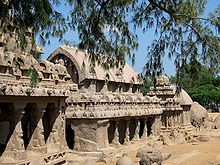- Mahendravarman I
-
Mahendravarman I (Tamil: மகேந்திரவர்மன்) (600–630 CE)[1] was a Pallava king who ruled the Northern regions of what forms present-day Tamil Nadu in India in the early 7th century. He was the son of Simhavishnu, who defeated the Kalabhras and re-established the Pallava kingdom.
During his reign, the Chalukya king Pulakesin II attacked the Pallava kingdom. The Pallavas fought a series of wars in the northern Vengi region, before Mahendravarman decimated his chief enemies at Pullalur (according to Pallava grants at Kuram, kasakudi and tadantottam). Although Mahendravarman saved his capital, he lost the northern provinces to Pulakesin.[2]
Many scholars have opined that Mahendra's patronage and liking for Jainism in his initial years may have caused him to give up the aggressive warlike attitude that generally went alongside all of Pallava and Chola monarchs of yore and most notedly with his great warrior father Simhavishnu who had subdued all the kingdoms of the south and also Srilanka. This might in turn have encouraged his enemies the Chalukyas who exploited it well to their advantage.[citation needed]
Mahendravarman was succeeded to the throne by his more famous son Narasimhavarman I in 630 CE.[1]
Contents
Patronage of Arts and Architecture
Mahendravarman was a great patron of letters and architecture. He was the pioneer of Rock-cut Architecture amongst the Pallavas. In the inscription at the Mandagapattu rock-cut temple, it is claimed that the temple was built without wood, brick, mortar or metal. The five-celled cave temple at Pallavaram was also built during his reign.[3]
Fine examples of his rock-cut temples can been witnessed at Mahabalipuram, (Satyagirinathar and Satyagirishwarar twin temples), Siyamangalam (the Siva temple Avanibhajana Pallaveswaram) in North Arcot district and the upper rock-cut temple at Trichy. Apart from the Siva temples, Mahendravarman also excavated a few Vishnu cave temples, the Mahendravishungrha at Mahendravadi, and the Ranganatha temple both at Singavaram both in present-day North Arcot district.[4]
He was also the author of the play Mattavilasa Prahasana, a farce concerning Buddhist and Saiva ascetics. He is also claimed to be the author of another play called Bhagavadajjuka,. This is evident by the inscriptions found at Mamandur cave shrines (near Kanchipuram - this place is mentioned as Dusi Mamandur to avoid confusions with other places by the same name). However, there is an alternate view that attributes this play to Bodhayana.[5] He is known to be the father of the Tamil script from which the contemporary Tamil script has evolved. The kudiyamalai(near salem) cave inscription describes his aptitude in fine arts.[citation needed]Religion
Mahendravarman was initially a patron of the Jain faith, but he converted back into the Saiva faith under the influence of the Saiva saint Appar.[6][7] It may be noted here that this conversion took place by volition and the Saiva saint's philosophical activities were mostly targeted against Jain monks who were on a conversion spree within the kingdom. This is testified in the inscriptions at the rock cut temple in Ponmalai near Trichy.[citation needed]
Mahendravarman IPallava dynastyPreceded by
SimhavishnuPallava dynasty
600–630Succeeded by
Narasimhavarman INotes
- ^ a b Hall, John Whitney, ed (2005) [1988]. "India". History of the World: Earliest Times to the Present Day. John Grayson Kirk. 455 Somerset Avenue, North Dighton, MA 02764, USA: World Publications Group. p. 246. ISBN 1572154217.
- ^ KAN Sastri, A History of South India, p136
- ^ KAN Sastri, A History of South India, p412
- ^ KAN Sastri, A History of South India, p413
- ^ KAN Sastri, A History of South India, p313
- ^ KAN Sastri, A History of South India, p382-383
- ^ Stein, p 122
References
- Prasad, Durga (1988). History of the Andhras up to 1565 A. D.. Guntur, India: P. G. Publishers.
- Sastri, K A N (2008). A History of South India (4th ed.). New Delhi, India: Oxford University Press.
- Stein, Burton (1998). A history of India. Cambridge, MA: Blackwell Publishers. ISBN 0-631-20546-2.
Categories:- Indian monarchs
- Pallava kings
Wikimedia Foundation. 2010.

